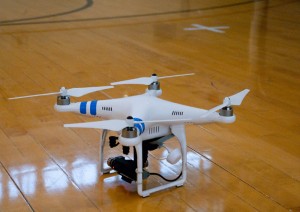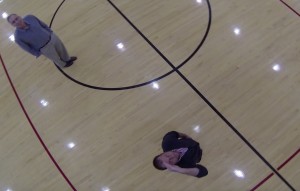Drone aerial photography boldly takes communications program to new heights.
Drone aerial photography boldly takes communications program to new heights.
What catches your attention first is the sharp buzzing sound, as if a swarm of bees was in flight. But the prickling sensation passes quickly as you take notice of the futuristic, four-legged craft moving through the air, sweeping past observers on the ground staring skyward, amazed, in kidlike wonder. Drone technology has arrived – most specifically, to the Communications Department at Adelphi University.
Armed with a 4K Go-Pro camera, the drone will allow the program to shoot aerial photography. The first results, a test run in the university gym, were remarkable. A representative from B&H photo was present for a demonstration as members of the department watched with more than a bit of awe as the drone circled to the heights of the 70-foot-high gym. Bad weather cancelled an outdoor demonstration, but the technology proved its versatility indoors with its stunning high definition imagery.
The quad-copters look like mini helicopters (about the size of a football). The B&H operator worked with a digital remote control that looked like that of a small game consul. Using his control, he directed the drone’s flight path, at times keeping the copter in a hovering position. In flight, the small Go-Pro camera retained its steady and mesmerizing video-imaging.
“The camera is gyroscopically balanced and its much like the controls of a well-designed video game,” says Tom Campbell, Technical Director of the department.
Drone technology with its high definition capabilities offers a tremendous opportunity for Adelphi students. “Drone photography is at the cutting edge of contemporary moving image practice,” says Sam Grogg, the dean of the College of Arts and Sciences. “Literally a whole new perspective for our students to explore.”
The revolutionary nature of this technology is not lost upon faculty in the communications department. John Drew, who teaches digital media and public relations, already has plans to utilize aerial photography for a major project in his class, Strategic Public Relations. Students will be conducting a publicity campaign for Operation Splash, a conservation-based non-profit in Freeport dedicated to cleaning Long Island’s coastal waterways. Since 1990, its 3,000 members have pulled nearly two million pounds of debris from these waters.
“Yet many Long Islanders have no idea who they are and what sort of work they are up to and the challenges they face,” says Drew. “My Strategic PR class is attempting to help them gain more visibility and particularly among young people.”
 Drone photography will have its first official run during the first big clean-up of the year which brings out hundreds of people—and also hundred of pounds of ocean trash. “We hope to be there both on the ground and, now, with this major green light in the sky,” says Drew.
Drone photography will have its first official run during the first big clean-up of the year which brings out hundreds of people—and also hundred of pounds of ocean trash. “We hope to be there both on the ground and, now, with this major green light in the sky,” says Drew.
“This project is very much in keeping with the direction of the communications program,” says chair Paul Thaler. “We want to get our students out into the community where they can do their good work. John’s class has a terrific opportunity here in helping raise awareness about water conservation and drone photography will make that effort even more visible.”
The introduction of the technology will open the door to new video-making possibilities, and the program is exploring ways in which aerial photography can be used to bring student projects, literally, to new heights.
“Drone technology, put simply, is a game changer for independent filmmakers and digital media producers,” says Drew. “Being able to enhance digital narratives with aerial perspectives makes visual storytelling possibilities that much more powerful.”
This article appeared in the Spring 2015 edition of The Front Page, the Department of Communications newsletter.
For further information, please contact:
Department of Communications
Blodgett Hall Room 113
p – 516.877.4905
